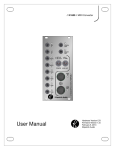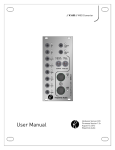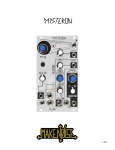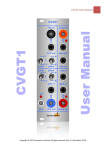Download Midi 3 Manual - Pittsburgh Modular
Transcript
MIDI 3 MANUAL PITTSBURGH MODULAR SYNTHESIZERS Extremely Full Featured MIDI to CV Converter includes a complete set of mono and duophonic midi response modes, dedicated CC and velocity outputs, multiple clock source options, and robust arpeggiator. This module is deep. THREE PERFORMANCE MODES Monophonic Mode works great when using a modular as a single voice synthesizer patch. Channel 2 Gate and CV outputs mirror the outputs of Channel 1. Monophonic Mode has several keyboard responses to choose from: last note priority, low note priority, and high note priority. Each response is available with and without gate retriggering. Duophonic Mode uses the two sets of Gate and CV outputs to allow two notes to be played simultaneously. The first midi note is sent to Channel 1 Gate and CV outputs and the second is sent to Channel 2 Gate and CV outputs. Duophonic Mode has three keyboard response modes to choose from. Unused channel and new note priority, unused channel and low note priority, and split keyboard priority. Duophonic mode is perfect when working with a two voice modular synthesizer patch. THREE CLOCK SOURCES Internal Clock utilizes the TAP tempo button to modify the rate of the internal clock. The internal clock is used to clock the arpeggiator and is also output to the CLOCK jack. External Midi Clock responds to midi start/ stop messages and midi tempo from an external midi clock source. The external midi clock is used to clock the arpeggiator and is also output to the CLOCK jack. In external midi clock mode, the tap tempo button cycles through five available clock divisions. External Gate Clock responds to gate signals patched into the CLOCK jack. The external gate clock is used to clock the arpeggiator. With the external gate clock source, the tap tempo button cycles through six available clock divisions. ADDITIONAL FEATURES Assignable Midi Channel can be assigned to respond to all channels or any individual midi channel. Arpeggiator Mode includes multiple mono and duophonic responses to choose from. Available responses are monophonic response as played, double triggered monophonic response as played, random monophonic response, random monophonic with a random Channel 2 gate, and random duophonic response with dual random gates. The arpeggiator can be clocked using tap tempo, midi clock, or external gate. Assignable Pitch Bend Range assignable between 2 semitones and 2 octaves. Assignable Control Change easily set the CC # the Midi 3 responds to. Velocity Response Output based on last active note. Gate Hold Function allows arpeggiator and midi note latch. NAVIGATING THE THREE PERFORMANCE MODES The MODE Button cycles between MONOphonic, DUOphonic, and ARPeggiator modes. The selected mode is identified by the illuminated yellow LED. The selected mode is saved in memory and recalled when the Midi 3 module is powered on. MONOPHONIC MODE Monophonic Mode outputs a single CV and gate signal based on the active midi note. Channel 2 CV and gate outputs are identical to Channel 1 CV and gate outputs. Up to 10 note recall when multiple keys are pressed at once. The EDIT Button cycles between 6 different Monophonic Response Types. The selected type is identified by a blinking MONO LED. The number of times the LED blinks identifies the selected Monophonic Response Type. The selected Monophonic Response Type is saved in memory and recalled when the Midi 3 module is powered on. RESPONSE TYPES 1. Last Note Priority with Gate Retrigger - Last note played sounds when multiple notes are active. Gate retriggers for every new note. 2. Last Note Priority - Last note played sounds when multiple notes are active. Gate triggers only when a single note is active. 3. Low Note Priority with Gate Retrigger - Lowest note played sounds when multiple notes are active. Gate retriggers for every new note. 4. Low Note Priority - Lowest note played sounds when multiple notes are active. Gate triggers only when a single note is active. 5. High Note Priority with Gate Retrigger - Highest note played sounds when multiple notes are active. Gate retriggers for every new note. 6. High Note Priority - Highest note played sounds when multiple notes are active. Gate triggers only when a single note is active. DUOPHONIC MODE ARPEGGIATOR MODE Duophonic Mode outputs a pair of CV and gate signals based on two active midi notes. Channel 1 CV and gate outputs work together with Channel 2 CV and gate outputs to provide a duophonic response. Arpeggiator Mode outputs a single CV and gate signal or 2 independent CV and gate signals based on the selected arpeggiator response type. Up to 10 note recall when multiple keys are pressed at once. The arpeggiator cycles through the selected notes. Enabling the Hold function by pressing the HOLD button allows the arpeggiator continues to cycle through the last set of selected notes. The set of selected notes resets when the arpeggiator receives a midi note off message. The EDIT Button cycles between 3 different Duophonic Response Types. The selected type is identified by a blinking DUO LED. The number of times the LED blinks identifies the selected Duophonic Response Type. The selected Duophonic Response Type is saved in memory and recalled when the Midi 3 module is powered on. RESPONSE TYPES The EDIT Button cycles between 5 different Arpeggiator Response Types. The selected type is identified by a blinking ARP LED. The number of times the LED blinks identifies the selected Arpeggiator Response Type. The selected Arpeggiator Response Type is saved in memory and recalled when the Midi 3 module is powered on. 1. Unused Channel and New Note Priority - Unused Midi 3 output channel used first. If multiple notes are active, oldest note is replaced with new note. RESPONSE TYPES 2. Unused Channel and Low Note Priority - Unused Midi 3 output 1. Monophonic Notes Played in Order - CV 1 and CV 2 outputs are the channel used first. If multiple notes are active, highest note is replaced with new note. This mode works well when playing a bass and lead line. same. Gate 1 and gate 2 trigger with a 100% probability. 3. Split Keyboard - CV 1 and Gate 1 respond to midi notes 0 to 23. CV 2 CV 2 outputs are the same. Gate 1 and gate 2 trigger trigger twice in a row with a 100% probability. and Gate 2 respond to midi notes 24 to 127. Last note priority used when multiple notes are active. CV 2 has up to 5 note memory when multiple keys are pressed at the same time. 2. Monophonic Notes Played Double Trigger in Order - CV 1 and 3. Monophonic Random with Random Gate 2 - CV 1 and CV 2 output the same randomly selected note. Gate 1 triggers with a 100% probability. Gate 2 triggers with a 60% probability. 4. Duophonic Random with Random Gate 2 - CV 1 and CV 2 outputs are independently random. Gate 1 triggers with a 100% probability. Gate 2 triggers with a 60% probability. 5. Duophonic Random with Dual Random Gates - CV 1 and CV 2 outputs are independently random. Gate 1 and Gate 2 trigger with a 60% probability. MIDI OUTPUTS MIDI 3 CLOCK The Midi 3 has 3 sets of outputs. Channel 1, Channel 2, and Expression outputs. Channel 1 and Channel 2 each have a Gate and CV output. The expression section contains a dedicated midi control change (CC) output and a midi note velocity output. The Midi 3 has 3 clock sources: internal, external midi, and external gate. The clock is used to clock the arpeggiator. Internal clock and external midi clock output to the CLOCK jack. The clock source is selected using the Edit Mode (see EDIT MODE on the next page). Internal Clock - The internal Midi 3 clock utilizes the TAP tempo button to modify the rate of the internal clock. 2 or 3 taps are needed to determine the internal clock tempo. Channel 1 Gate Out - Channel 1 gate outputs a signal of either 0v (off) or 5v External Midi Clock - The external midi clock responds to midi start/stop (on). This signal can be used to trigger an envelope generator, sequencer, logic module, or any other module that requires a gate input. The Channel 1 Gate is active when the Channel 1 LED is lit. messages and midi tempo from an external midi clock source. The external midi clock is used to clock the arpeggiator and is also output to the CLOCK jack. In external midi clock mode, the TAP tempo button cycles through five available clock divisions: whole note, 1/2 note, 1/4 note, 1/8 note, 1/16 note. Channel 1 CV Out - Channel 1 CV outputs a variable control voltage between 0v and 10v. This signal is calibrated to track at 1 volt per octave and can be used to control the pitch of an oscillator, the frequency of a filter, or any other module that works with a control voltage signal. CHANNEL 2 Gate Out - Channel 2 gate outputs a signal of either 0v (off) or 5v (on). This signal can be used to trigger an envelope generator, sequencer, logic module, or any other module that requires a gate input. The Channel 2 Gate is active when the Channel 2 LED is lit. CHANNEL 2 CV Out - Channel 2 CV outputs a variable control voltage between 0v and 10v. This signal is calibrated to track at 1 volt per octave and can be used to control the pitch of an oscillator, the frequency of a filter, or any other module that works with a control voltage signal. CC Expression Out - 0v to 5v output based on assigned Control Change number. Velocity Expression Out - 0v to 5v output based on Channel 1 midi note velocity. External Gate Clock - The external gate clock responds to gate signals patched into the CLOCK jack. The external gate clock is used to clock the arpeggiator. In external gate clock mode, the TAP tempo button cycles through six available clock divisions: /1, /2, /4, /8, /16, /32. EDIT MODE Edit mode is used to modify the midi channel, pitch bend range, control change (CC) number, and clock source parameters. The parameters are printed below the red LEDs. All changes made in Edit Mode are saved in memory and recalled when the Midi 3 module is powered on. Enable Edit Mode by pressing and holding EDIT button down for 1 second. The LED of the selected parameter will begin to blink. Cycle through Parameters by tapping the EDIT button. Modify a Parameter by selecting the parameter to edit and tapping the HOLD button. Disable Edit Mode by pressing and holding EDIT button down for 1 second. EDIT MIDI CHANNEL - The MIDI CH parameter assigns the midi channel. Pressing the HOLD button cycles through available options. Respond to all channels followed by channel 1 through channel 16. The number of times the LED blinks corresponds to the selected midi channel: 1 blink for channel 1, 2 for channel 2, etc… For all channels, the LED will blink at a steady rate. PITCH BEND RESPONSE - The P. BEND parameter assigns the range of the pitch bend. Pressing the HOLD button cycles through available options: 2 semitones (+/- 2 notes), 8 semitones (+/- 5th), 12 semitones (+/- 1 octave), 24 semitones (+/- 2 octaves). CONTROL CHANGE NUMBER ASSIGN - The CC# parameter assigns the control change number that the Midi 3 responds to. The control change number is assigned to the control change number of the last control change message it receives while in Edit Mode. CLOCK SOURCE - The CLOCK parameter assigns the clock source. Pressing the HOLD button cycles through available options: internal clock, external midi clock, external gate clock. FACTORY RESET Performing a factory reset returns all of the stored settings to the default setting. Hold down MODE for 4 seconds. The LEDs will blink to show the reset is complete. EURORACK SPECS Width - 8hp Power Consumption - 50mA Depth - 35mm













